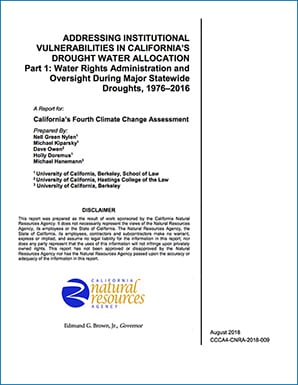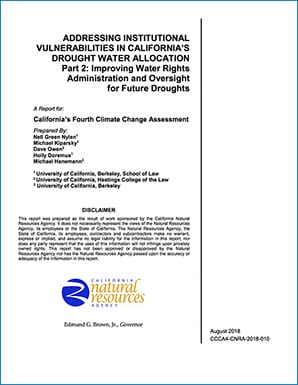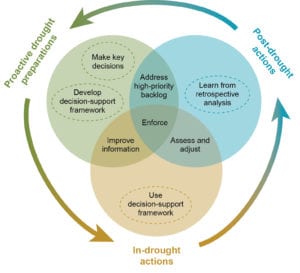August 2018
California droughts are likely to become more frequent, longer, and more intense in the future, posing increasing challenges for water management, and raising the stakes for effective drought response. Past droughts have stress tested California’s water management institutions, revealing vulnerabilities that could impair effective adaptation to climate change. The State Water Resources Control Board (Board) is a key water decision maker whose actions affect how scarce water resources are allocated among different human and environmental uses during droughts. In a pair of reports published as part of California’s Fourth Climate Change Assessment, we examine how the Board has carried out its water rights responsibilities during past droughts and offer recommendations for improving the agency’s future drought response.
Part 1: Water Rights Administration and Oversight During Major Statewide Droughts, 1976–2016

In the first report, we analyze the strategies the Board used for water rights administration and oversight during the last four major statewide droughts. Our review suggests that:
- The Board responded differently to each of the last four major statewide droughts, sometimes taking on a very active role, and sometimes taking a more hands-off approach. In particular, it put more effort into water rights oversight during the 1976–1977 drought and the 2012–2016 drought than it did during the two intervening droughts.
- A lack of sufficient pre-drought planning and preparation was an important factor in the Board’s variable drought responses. The Board often needed to improvise important aspects of its drought response strategies in the midst of drought crises.
- Over-reliance on in-drought improvisation hindered effective drought response. Although the Board has made significant and creative advances in drought management, it also spent valuable time during each drought marshalling its resources to make basic decisions about which response strategies to use, what to prioritize, and how to engage with stakeholders. Contemporaneous direction from political leadership, especially the governor, heavily influenced these decisions. Water users did not know what to expect from the Board in advance, and therefore found it challenging to make their own drought preparations.
- More proactive planning and preparation would improve the Board’s future drought responses. To prepare for the more frequent and intense droughts we expect in the future, and set the stage for more timely and effective in-drought decision making under pressure, the Board can shift from reactive adaptation in the midst of droughts to more anticipatory adaptation based on drought contingency planning.
Part 2: Improving Water Rights Administration and Oversight for Future Droughts

The second report builds on the retrospective analysis in Part 1 by offering specific recommendations for improving the Board’s drought response capabilities. To ensure that during times of drought water is allocated among different human and environmental water uses transparently, efficiently, predictably, and in accordance with the priorities that flow from state and federal law, we suggest that the Board:
- Adopt a contingency-based framework to support drought decision making. The goal setting, scenario planning and forethought required to develop a useful decision-support framework, as well as the structure it would bring to the decision-making process, would make the Board more nimble, empowering more timely and effective responses during future droughts.
- Make key policy decisions in advance of droughts. The Board would maximize the transparency, timeliness, and effectiveness of its drought decision making by (a) setting and implementing instream flow requirements that adequately protect fish and wildlife in priority water bodies over the full range of hydrologic conditions, (b) defining and implementing minimum human health and safety protections, and (c) establishing clear procedures for implementing curtailments of diversions during times of water shortage.
- Strategically improve decision-related information, data integration, and interoperability. This includes information about water supply, water diversion and use, pre-1914 and riparian water rights, and ecological considerations.
- Maximize learning from droughts. Following a drought, the Board should evaluate how effective its drought response actions were and, if it adopts a contingency-based decision support framework, how well that framework performed. This will allow the Board to identify needed improvements and follow up by adjusting drought decision support structures and reprioritizing further drought preparatory work.
- Prioritize water rights enforcement between droughts. Although droughts highlight and provide added incentive to address water right compliance problems, enforcement between droughts is also critical.
We view these actions as crucial components of effective climate adaption for California and encourage the Board to begin implementing them now, so that it is better prepared to face the challenges the next drought brings. For each, the Board can capitalize on synergies between drought and non-drought work to achieve better water management outcomes, greater clarity for water users, and more efficient use of the Board’s, and the state’s, resources.

Download the Reports:
Read the Legal Planet blog series:
Part 1: Why It’s Important to Prepare for Drought During a Deluge (March 7, 2019)
Part 2: Water Rights Administration and Oversight During Past California Droughts (March 15, 2019)
Part 3: Actions to Improve California Water Rights Administration and Oversight for Future Droughts (March 29, 2019)
Part 4: A Contingency-Based Framework to Support Drought Decision Making (April 8, 2019)
Part 5: Developing a Decision-Support Framework for Curtailment (May 13, 2019)
Part 6: Making Key Policy Decisions in Advance of Droughts (May 24, 2019)
For More Information:
Contact Nell Green Nylen, Senior Research Fellow, Wheeler Water Institute, Center for Law, Energy & the Environment
This project was funded by the California Natural Resources Agency as part of California’s Fourth Climate Change Assessment, with additional support from the UC Water Security and Sustainability Research Initiative (funded by the University of California Office of the President, UCOP Grant No. 13941).
Suggested Citations
Green Nylen, Nell, Michael Kiparsky, Dave Owen, Holly Doremus, Michael Hanemann. (University of California, Berkeley). 2018. Addressing Institutional Vulnerabilities in California’s Drought Water Allocation, Part 1: Water Rights Administration and Oversight During Major Statewide Droughts, 1976–2016. California’s Fourth Climate Change Assessment, California Natural Resources Agency. Publication number: CCCA4-CNRA-2018-009. 193 pp. Available at: http://www.climateassessment.ca.gov/techreports/docs/20180827-Water_CCCA4-CNRA-2018-009_ada.pdf or https://www.law.berkeley.edu/research/clee/research/wheeler/drought-water-allocation/.
Green Nylen, Nell, Michael Kiparsky, Dave Owen, Holly Doremus, Michael Hanemann. (University of California, Berkeley). 2018. Addressing Institutional Vulnerabilities in California’s Drought Water Allocation, Part 2: Improving Water Rights Administration and Oversight for Future Droughts. California’s Fourth Climate Change Assessment, California Natural Resources Agency. Publication number: CCCA4-CNRA-2018-010. 72 pp. Available at: http://www.climateassessment.ca.gov/techreports/docs/20180827-Water_CCCA4-CNRA-2018-010_ada.pdf or https://www.law.berkeley.edu/research/clee/research/wheeler/drought-water-allocation/.